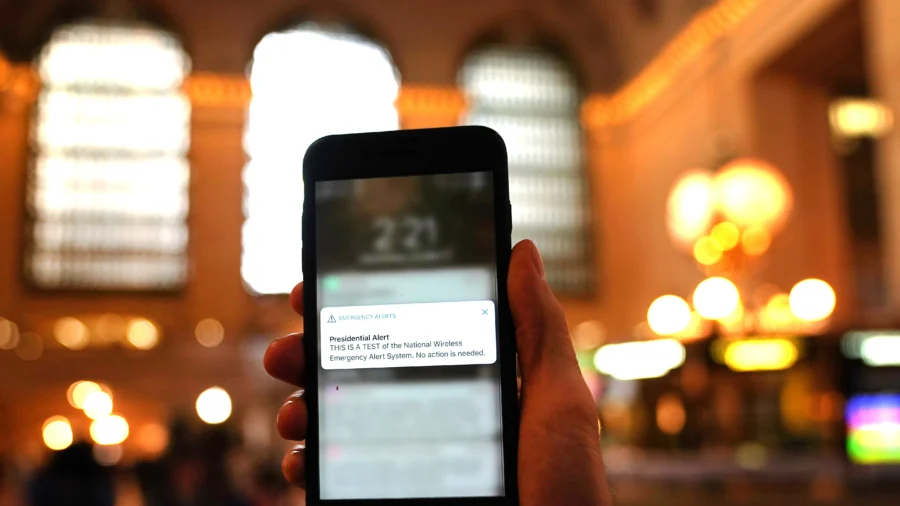A “presidential alert” was sent out at around 2:18 p.m. ET on Oct. 4 to test a national emergency system, causing cellular phones, televisions, and radios to emit the familiar alarm sound.
“THIS IS A TEST of the National Wireless Emergency Alert System,” it said. “The purpose is to maintain and improve alert and warning capabilities at the federal, state, local, tribal, and territorial levels and to evaluate the nation’s public alert and warning capabilities.”
It added that “no action is required by the public.”
Notably, the emergency test alert bulletin interrupted White House press secretary Karine Jean-Pierre’s news conference on Wednesday.
On broadcast TV shows and radio programs, they were interrupted as the emergency message was sent. That message stated: “This is a nationwide test of the Emergency Alert System, issued by the Federal Emergency Management Agency, covering the United States from 14:20 to 14:50 hours ET. This is only a test. No action is required by the public.”
Months in advance, the Federal Emergency Management Agency (FEMA) and the Federal Communications Commission (FCC) sent out a notice saying that the alert system would be tested on Oct. 4. Those who opted out of wireless alerts on their cellphones didn’t receive the message.
As long as the device is “switched on, within range of an active cell tower, and whose wireless provider participates in WEA,” people would get the wireless emergency alerts on their phones. WEAs are described as emergency messages “that are sent directly to your phone by authorized government alerting authorities through your mobile carrier,” including FEMA, the FCC, state agencies, and the U.S. National Weather Service.
“All wireless phones should receive the message only once,” the FEMA bulletin in August said. “The following can be expected from the nationwide WEA test: Beginning at approximately 2:20 p.m. ET, cell towers will broadcast the test for approximately 30 minutes. During this time, WEA-compatible wireless phones that are switched on, within range of an active cell tower, and whose wireless provider participates in WEA, should be capable of receiving the test message.”
TOMORROW, OCT. 4: There will be a nationwide emergency alert test sent to all TVs, radios, and cell phones at 2:20 p.m. ET.
Important information and what can be expected from the nationwide test: https://t.co/2yv5y297wb
Frequently Asked Questions ⤵️ pic.twitter.com/gWjCynM8zb
— FEMA (@fema) October 3, 2023
Why?
Under federal law, television and radio broadcasters have to follow the nation’s EAS to take over channels or stations “within 10 minutes during a national emergency,” FEMA’s website says.
“With the combination, you’re going to catch a wide swath of people,” Joseph Trainor, with the University of Delaware’s Disaster Research Center, told CBS News this week.
He told the outlet: “We know that they are effective systems. Like any system, there are strengths and weaknesses. How many characters you can use, how much you can transmit, how fast you can get it out. Every system has limits, and that’s why we tell people, when we are giving advice about building warning systems, you don’t ever want to rely on just one thing.”
The test alert scheduled for October isn’t the first time it has been deployed. On Aug. 11, 2021, FEMA and the FCC carried out what they said was the sixth nationwide test of the EAS. Prior tests were conducted in 2011, 2016, 2017, 2018, and 2019, according to FEMA.
Officials say the tests are designed to be a test in the case of actual emergencies. They are also designed to see whether the system can run smoothly if there is a natural disaster, terrorism, a nuclear attack, or another danger to public safety.
False Alarms
There have been false emergency alert alarms over the years. Notably, a false alert was sent out in 2018 in Hawaii when the state’s Emergency Management System erroneously warned that a ballistic missile attack on the islands was imminent.
The now-retracted alert said: “Ballistic Missile Threat Inbound To Hawaii. Seek Immediate Shelter. This Is Not A Drill.” Officials took about 30 minutes to clarify that the message was sent out in error.
In 2022, during wildfires in California, an immediate evacuation notice was sent by the Los Angeles County Office of Emergency Management for Los Angeles, the Eastern North Pacific Ocean, and Port Conception to Guadalupe. The text listed “Eastern North Pacific Ocean” or “Eastern North Pacific” twelve different times before the Ventura County Sheriff’s Office said it was an error.
From The Epoch Times


